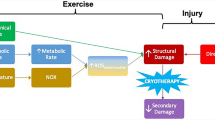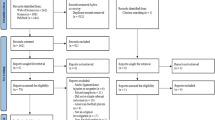Abstract
Mangled extremities were classically managed by amputation. But over the past few decades, with the advancement in surgical techniques, an increased number of limb salvages have been possible. As muscles usually get damaged in such grievous injuries, a thorough understanding of muscle regeneration may give a better insight into muscle healing in these injuries. Muscles are composed of slow and fast fibers which can be represented by slow and fast myosin, respectively. There are some animal studies which reported differential regeneration of slow and fast muscle fibers during muscle healing. We conducted this pilot study to find out whether the same holds true for muscle healing in mangled extremities also. This pilot study is designed in 15 patients with lower limb mangled extremities presenting to trauma center of PGIMER, Chandigarh, who were operated within 24 h of injury to see whether muscle healing in mangled extremities follows the same pattern. Biopsies were taken during initial surgery conducted within 24 h of injury and on the 7th day of injury when patient was posted again for secondary wound closure procedure or revision amputation. The biopsy samples were subjected to histopathological and immunohistochemistry examination using antibodies against fast and slow myosin. We found that the regenerating muscle fibers in the biopsy sample taken on the 7th day of injury showed only slow muscle fibers with the absence of fast muscle fibers when compared with the initial biopsy results showing differential regeneration of slow muscle fibers.




Similar content being viewed by others
References
Rush RM, Kjorstad R, Starnes BW, Arrington E, Devine JD, Andersen CA (2007) Application of the Mangled Extremity Severity Score in a combat setting. Mil Med 172:777–781
Lexell J, Henriksson-LarséN K, SjöStröM M (1983) Distribution of different fibre types in human skeletal muscles 2. A study of cross-sections of whole m. vastuslateralis. Acta Physiol Scand 117:115–122
Pette D, Staron RS (2000) Myosin isoforms, muscle fiber types, and transitions. Microsc Res Tech 50:500–509
Mourkioti F, Rosenthal N (2005) IGF-1, inflammation and stem cells: interactions during muscle regeneration. Trends Immunol 26:535–542
Prisk V, Huard J (2003) Muscle injuries and repair: the role of prostaglandins and inflammation. Histol Histopathol 18:1243–1256
Zatz M, Rapaport D, Vainzof M, Passos-Bueno MR, Bortolini ER, de Pavanello RC et al (1991) Serum creatine-kinase (CK) and pyruvate-kinase (PK) activities in Duchenne (DMD) as compared with Becker (BMD) muscular dystrophy. J Neurol Sci 102:190–196
McClung JM, Davis JM, Carson JA (2007) Ovarian hormone status and skeletal muscle inflammation during recovery from disuse in rats: ovariectomy and inflammation after muscle disuse. Exp Physiol 92:219–232
Sorichter S, Mair J, Koller A, Müller E, Kremser C, Judmaier W et al (2001) Creatine kinase, myosin heavy chains and magnetic resonance imaging after eccentric exercise. J Sports Sci 19:687–691
Whalen RG, Harris JB, Butler-Browne GS, Sesodia S (1990) Expression of myosin isoforms during notexin-induced regeneration of rat soleus muscles. Dev Biol 141:24–40
Blaveri K, Heslop L, Yu DS, Rosenblatt JD, Gross JG, Partridge TA et al (1999) Patterns of repair of dystrophic mouse muscle: studies on isolated fibers. Dev Dyn 216:244–256
Bourke DL, Ontell M (1984) Branched myofibers in long-term whole muscle transplants: a quantitative study. Anat Rec 209:281–288
Zimowska M, Kasprzycka P, Bocian K, Delaney K, Jung P, Kuchcinska K et al (2017) Inflammatory response during slow- and fast-twitch muscle regeneration. Muscle Nerve 55:400–409
Matsuura T, Li Y, Giacobino J-P, Fu FH, Huard J (2007) Skeletal muscle fiber type conversion during the repair of mouse soleus: potential implications for muscle healing after injury. J Orthop Res 25:1534–1540
Salvini TF, Morini CC, Selistre de Araújo HS, Ownby CL (1999) Long-term regeneration of fast and slow murine skeletal muscles after induced injury by ACL myotoxin isolated from Agkistrodoncontortrixlaticinctus (broad-banded copperhead) venom. Anat Rec 254:521–533
Lagord C, Soulet L, Bonavaud S, Bassaglia Y, Rey C, Barlovatz-Meimon G et al (1998) Differential myogenicity of satellite cells isolated from extensor digitorumlongus (EDL) and soleus rat muscles revealed in vitro. Cell Tissue Res 291:455–468
Scholzen T, Gerdes J (2000) The Ki-67 protein: from the known and the unknown. J Cell Physiol 182:311–322
Li LT, Jiang G, Chen Q, Zheng JN (2015) Ki67 is a promising molecular target in the diagnosis of cancer (review). Mol Med Rep 11:1566–1572
Russell AP, Feilchenfeldt J, Schreiber S, Praz M, Crettenand A, Gobelet C et al (2003) Endurance training in humans leads to fiber type-specific increases in levels of peroxisome proliferator-activated receptor-gamma coactivator-1 and peroxisome proliferator-activated receptor-alpha in skeletal muscle. Diabetes 52:2874–2881
Harber MP, Gallagher PM, Trautmann J, Trappe SW (2002) Myosin heavy chain composition of single muscle fibers in male distance runners. Int J Sports Med 23:484–488
Rodríguez L, López-Rego J, Calbet J, Valero R, Varela E, Ponce J (2002) Effects of training status on fibers of the musculusvastuslateralis in professional road cyclists. Am J Phys Med Rehabil 81:651–660
Bigard XA, Janmot C, Merino D, Lienhard F, Guezennec YC, D’Albis A (1996) Endurance training affects myosin heavy chain phenotype in regenerating fast-twitch muscle. J Appl Physiol 81:2658–2665
Funding
This study was funded by Indian Council of Medical Research (ICMR), Department of Health Research, New Delhi, India.
Author information
Authors and Affiliations
Corresponding author
Ethics declarations
Conflict of interest
There is no conflict of interest from any of the authors.
Ethical standard
The study was approved by the Institute’s Ethical Committee and was performed in accordance with the ethical standards laid down in the 1964 Declaration of Helsinki and its later amendments.
Informed consent
Informed consent was taken from the patients at the time of enrollment, the study procedure was explained in detail to all the enrolled patients, and they were made to understand that they could withdraw from the study at any point of the study period. The study has not altered any of the management protocols of these patients. Identity of the participants was kept confidential.
Additional information
Publisher's Note
Springer Nature remains neutral with regard to jurisdictional claims in published maps and institutional affiliations.
Rights and permissions
About this article
Cite this article
Sharma, G.R., Kumar, V., Kanojia, R.K. et al. Fast and slow myosin as markers of muscle regeneration in mangled extremities: a pilot study. Eur J Orthop Surg Traumatol 29, 1539–1547 (2019). https://doi.org/10.1007/s00590-019-02448-w
Received:
Accepted:
Published:
Issue Date:
DOI: https://doi.org/10.1007/s00590-019-02448-w




